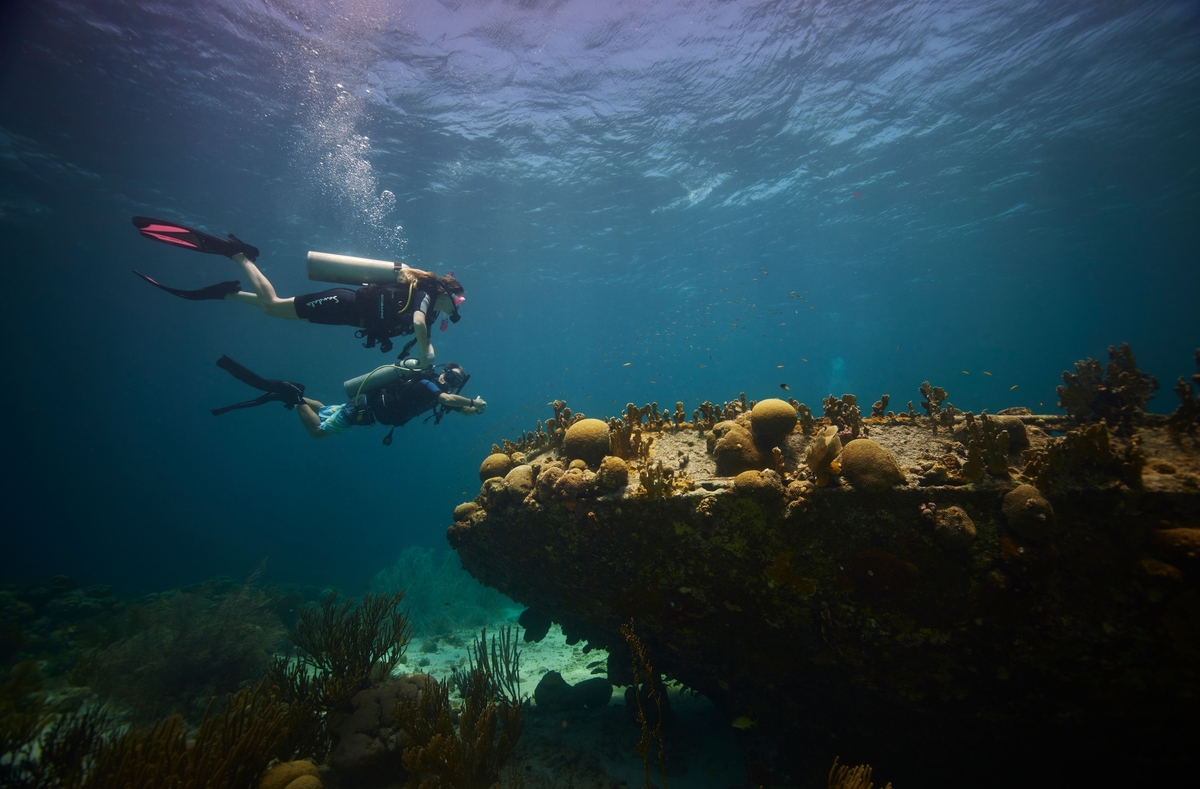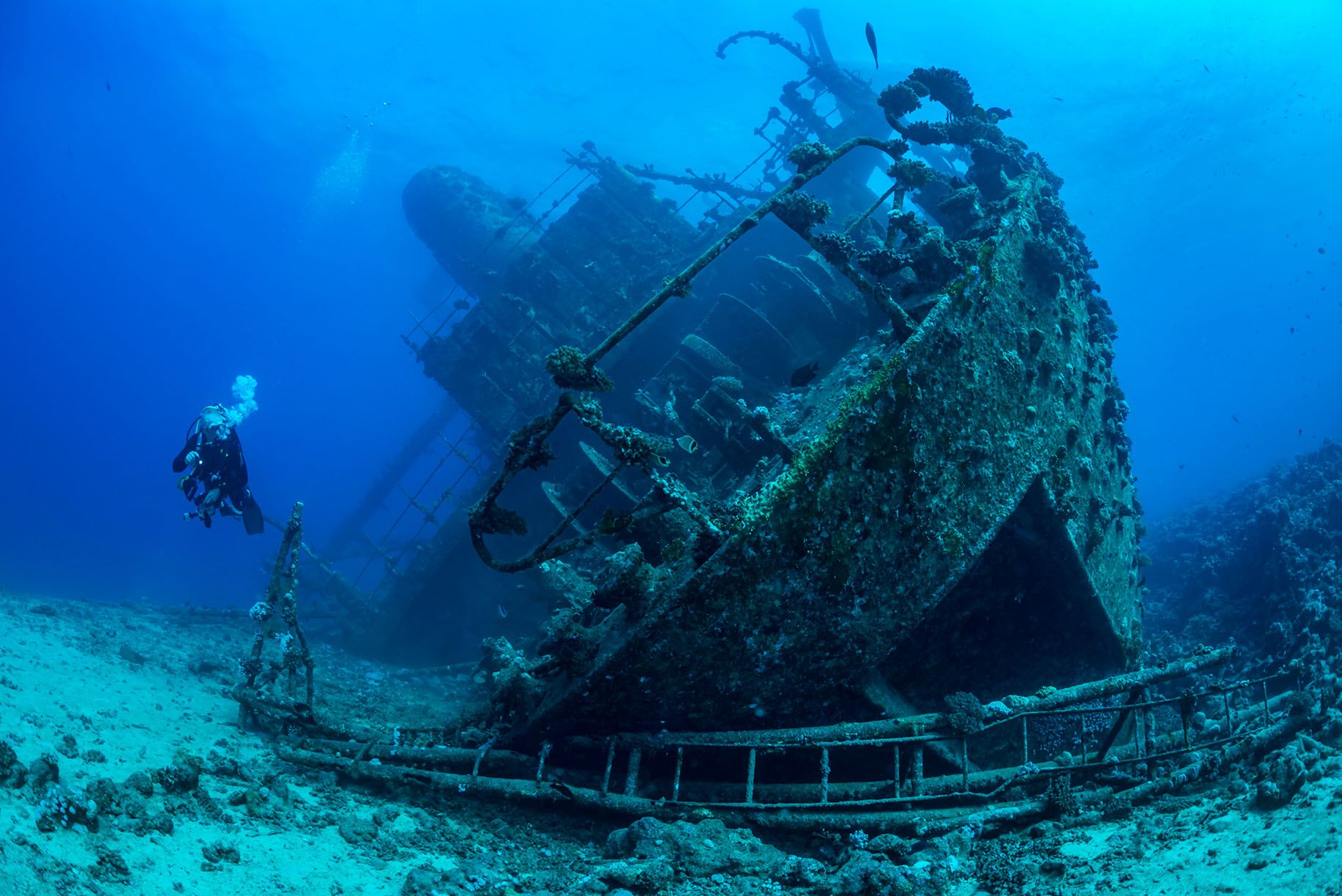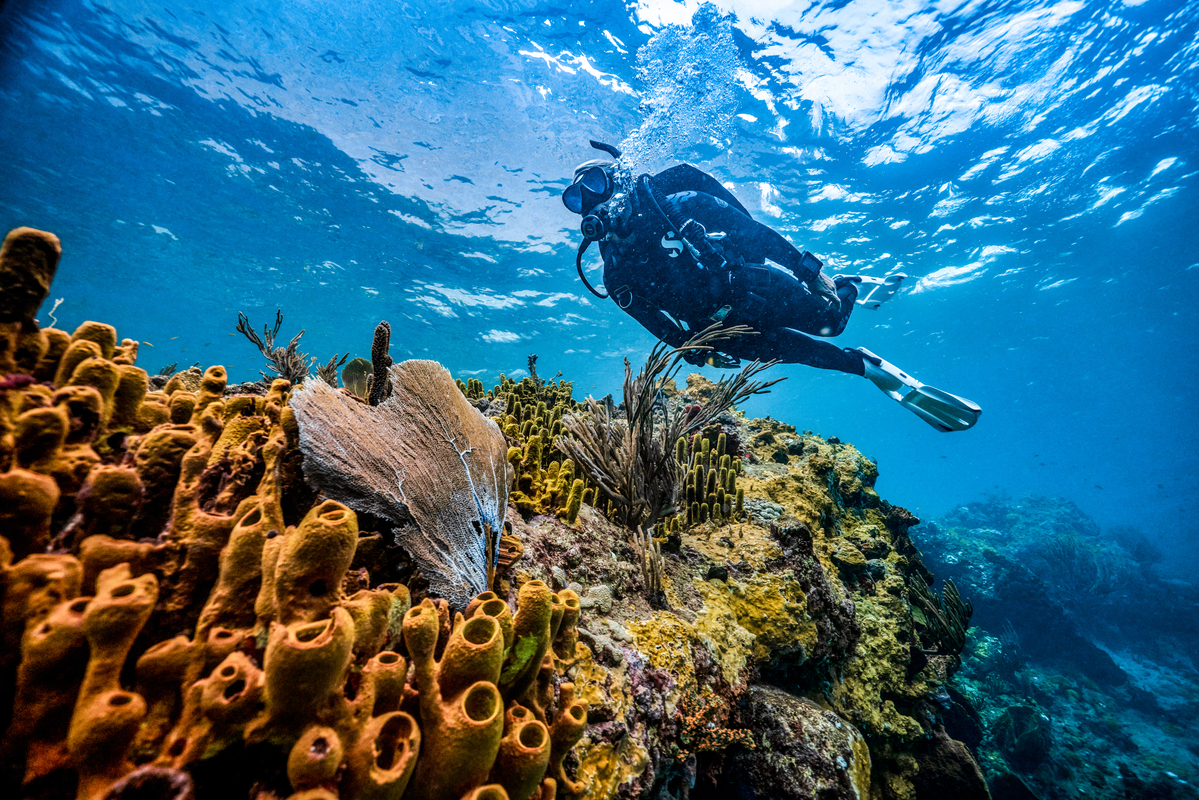The ultimate dream for scuba aficionados is to live near the ocean, in a place where they can go scuba diving every day. Not everyone is that fortunate, however, there are places in the world that offer scuba experiences so sublime, that they almost make up for not having a scuba friendly beach in your backyard.
The Caribbean island of Antigua is one of those places. There’s so much room for exploration of the ocean’s depths off the coasts of Antigua, that it’s beneficial to try to figure out what you’d like to see, even before arriving at the island. Diving in Antigua stands out even more for the fact that visitors to the island can also head out to Antigua’s sister isle Barbuda and dive off the coast there too. This means you’ll have two islands to explore in a part of the world that’s sure to reignite your appreciation of the world both above and below the ocean’s surface.
Expert tip: All-inclusive resort Sandals Grande Antigua on Dickenson Bay offers its PADI® certified guests free scuba diving trips (max. two tanks a day) as part of their all-inclusive package. This includes professional equipment and professional dive staff. Guests can also conveniently get PADI® certified at the resort at an additional cost.
Excited? You likely will be after you find out more about what you can see while scuba diving in Antigua!
In this article on the Sandals Blog:
The Antigua underwater scene
Sandals best dive spots in Antigua
Best time to dive in Antigua
Diving with Sandals Resorts in Antigua
Stay safe and dive in!

The Caribbean is known for its amazing dive opportunities, and each island offers a unique experience. In both Antigua and Barbuda, the attraction is the pristine and well-preserved reefs, which are home to marine life of all kinds. Just off the coast, you can wall dive, drift dive, or even explore shipwrecks like Jettias Wreck. Whether you’re just starting off and looking for a shallow dive with lots of great sightings, or something a little more advanced, you won’t have a hard time finding the right dive site for you in Antigua.
What you’ll see while diving in Antigua depends on the location and time of year, but generally you can spot things like parrotfish, angelfish, batfish, grunts, turtles, moray eels, lobster, eagle rays, barracuda, and in some places reef sharks, nurse sharks, and even black tip reef sharks. Playful dolphins sometimes make appearances as well. This of course is in addition to the many varieties of hard and soft coral, and other rock formations that define some of the most intricate underwater sites in Antigua.
Insider tip: Barbuda is a popular location for turtle watchers as many turtles swim to the island to nest every year. While scuba diving near Barbuda, depending on the time of year, you’re likely to spot lots of turtles, and even new hatchlings making their way into the ocean!
Dive Level: Novice

Wreck divers in Antigua can start off with an underwater exploration of the Jettias Wreck. Just west of Sandals Grande Antigua, the Jettias Wreck is one of the top dive sites on the island. The French steam powered freighter sank in 1817 and it is one of the oldest wrecks off the coasts of Antigua. During a dive here, you can expect to see trumpet fish, parrot fish, grunts, blue tangs, Spanish hogfish, barracuda and snapper.
Dive Level: Novice

The Pillars of Hercules reef, or Pillar’s Reef as it is also known, is described by many who go there as in “excellent condition”. “Shaped like fingers” visibility is fantastic at this reef, which is one of the reasons it is considered one of Antigua’s best. Sightings here include flounders, black durgons and many other species of reef fish. This is one of the diving experiences in Antigua that you’re likely going to want to repeat once you resurface!
Dive Level: Novice

Mary Kay Reef is well known for its abundance of soft coral heads and the eclectic collection of reef fishes. This is primarily a spur and groove site where there are a few small ledges and undercuts. Lobster and barracuda are usually present, and there’s also a high chance of spotting turtles and stingrays. Reef shark sightings here are possible, but less common.
Dive Level: Master

Starting at 40 ft and reaching about 80 ft in depth, Chimney Reef is best suited for divers with a wealth of confidence and experience. The name of this reef comes from its features – the rock face beneath the ocean at this location has a hole that goes up to the top of the ledge. It’s quite a sight to see and experience, as you swim along with Atlantic spadefish, black jacks, angel fish, barracudas, and nurse sharks, some of which love hanging out in the chimney. This extensive reef is ideal for drift diving.
Dive Level: Advanced

Rambo’s Reef is best suited for divers with more experience, looking for a deeper dive. The ledge here is a large part of the attraction, and it goes down 100 ft. There’s a valley to admire on the way back – be sure to pay attention to the intriguing marine species you’ll spot along the way, some of which will be just as interested in you, as you are in them! Sightings here often include reef fishes, turtles, lobster, stingrays, and more.
Dive Level: Novice

Monk’s Head is worth putting on your dive list while in Antigua. The maximum depth of this reef is around 50 ft, and this dive is ideal for scuba divers who want to keep things simple. While diving this circular coral knoll, look out for trumpet fish, parrot fish, snappers, Creole wrasse, Atlantic spadefish, and southern stingray.
Dive Level: Novice

Roads is a lesser known diving site in Antigua, but it’s one you can ask about once you arrive if you want a calm and easy dive. Coral heads are a prominent feature here, as are the short pillars you’ll spot under the waves. Aside from the fishes you’ll see going about their daily lives at the reef which literally resembles undersea roads, chances are high of running into different species of turtles.
Dive Level: Advanced

You’ll need to be past the beginner stages to make the most of Snappers Ledge in Antigua. As the name of this reef suggests, snappers are commonly seen here, as are other fish species including big eye jacks, Spanish mackerel and barracuda. The ledge here begins at the 50 ft mark and goes all the way to the 80 ft mark.
Dive Level: Novice

Cades Reef is perfect for both snorkelling and scuba diving as the reef is near the shore. Despite that, chances are high for cool sightings, including parrotfish, lobster, and eels, as well as eagle rays, moray eels, and barracuda further out. Sometimes nurse sharks like to swim in this area, particularly under the coral overhangs where they go to rest. Reef sharks have also been spotted here, and like nurse sharks, they are known to be a non-aggressive species.
Dive Level: Novice

If you’ve just received your diving certification in Antigua and you’re looking for a dive site that’s exciting yet easy to navigate, look no further than Kay Point Reef. This popular reef is circular in appearance, and sea fans, barrel sponges, and other types of coral are abundant at this location. Sometimes you may spot nurse sharks in this area, and there is also a chance of coming across black tip sharks, the latter of which is the second most seen shark in the Caribbean.
Like most Caribbean islands, there’s hardly a bad time to travel to Antigua. The weather on this Caribbean isle is consistent throughout the year (mid 80s). The driest months in Antigua are December to April, and as such, they’re associated with being the best time to go. This is also considered the peak season for travel to Antigua, which means there will likely be a high volume of tourists going to the island during these months. June to November are typically a little cloudier. Even still, if you travel during this time the weather will mostly remain sunny and accommodating – just like you’d envisioned in your holiday in Antigua!

Guests at any of the Sandals all-inclusive resorts can choose between early morning dives and afternoon dives, which eliminates the need to wake up super early every day of your holiday. Keep in mind though that some of the more advanced dive sites may be a bit further out, which might require some early morning rising if you’d like to go.
The Sandals dive team meets new divers all the time and are used to taking guests around to the most popular dive sites. If you show them what you’re capable of, chances are they’ll take you around to some of the more advanced dive sites, and consider where you’d like to go when they’re planning the daily dives.
All equipment is included for Sandals divers, which means you don’t have to bring anything along with you besides your wetsuit. At a small additional cost, you can rent a wetsuit if you choose to do so.
Even though you might just fall in love with the dive team, keep in mind that like most of the other staff at Sandals except for butlers and spa staff, tips are included in your all-inclusive package. Your genuine “thank you”, will do, though some people choose to thank the team or a particular team member for a full dive week with a handy dive gadget or a bottle of rum!
As you get set to dive every day of your all-inclusive holiday, you’ll be glad you don’t have to think about funnelling money every day into a new diving experience. Once you’re certified with Sandals (or certified prior to arrival), scuba diving will be free for the rest of your holiday (up to 2 tanks per day).
If you’re not PADI® certified yet, the best way to go about this to quickly get into the water once you arrive at Sandals is by starting e-learning before you get there. This will help you get right into the certification process once you arrive. To get certified with Sandals, you’ll need to register and then pay the regular PADI® certification fees, learn about the equipment you’ll be using, and do some pool training. Once you’re comfortable and familiar with all the safety regulations and communication signals, you’ll be just about ready to dive in.
Tip: While you’re gearing up for your Sandals scuba holiday, check out some of the Sandals scuba courses or have a look at the scuba dive sites available near the resort.
As enthusiastic as you may be about a diving holiday, it’s important to make sure you’re acquainted with all the necessary safety protocols before diving in.
The first of these is getting certified. Once this is done, you’ll need to figure out who to dive with. Once you’re signed up and ready to dive, get familiar with your equipment, and make sure everything checks out.
After that, the other thing you’ll need to keep at the forefront of your mind are the instructions of your dive master. While exploring the otherworldly sights and sounds beneath the waves, remember to stay close to your dive buddy. Oh, and definitely look into dive insurance ahead of time to cover any eventualities, including medical emergencies!
Read ‘Top 50 Things To Do For An Unmatched Holiday’ to see what else you can do in Antigua!